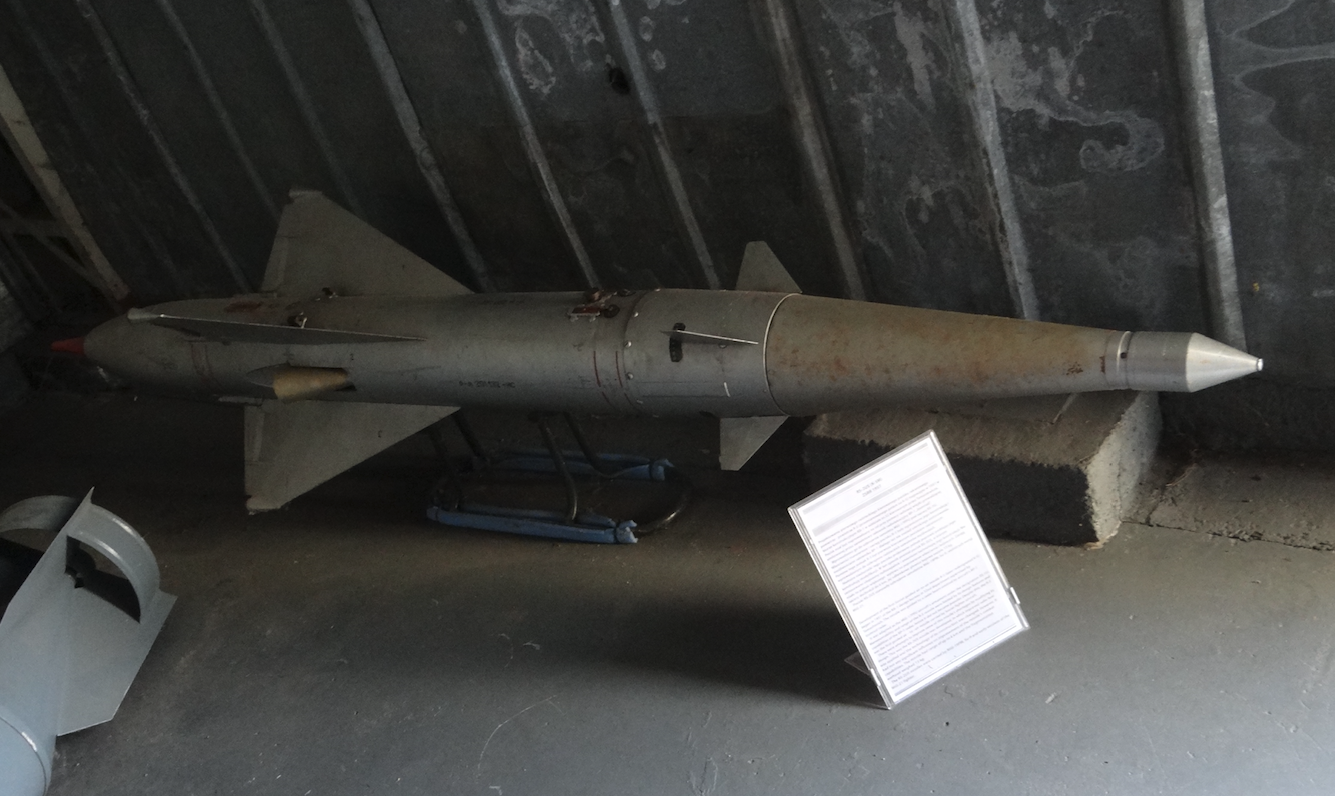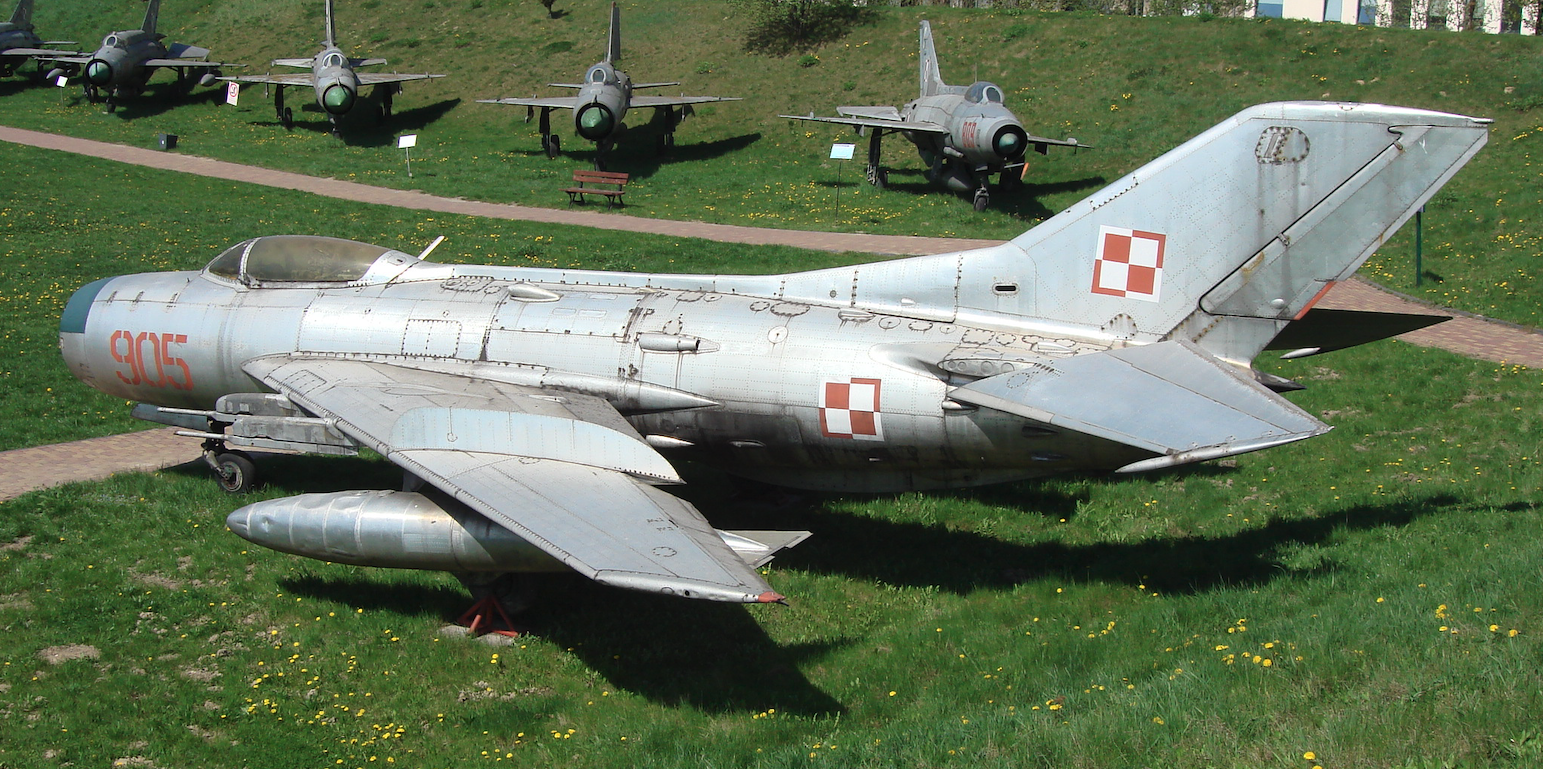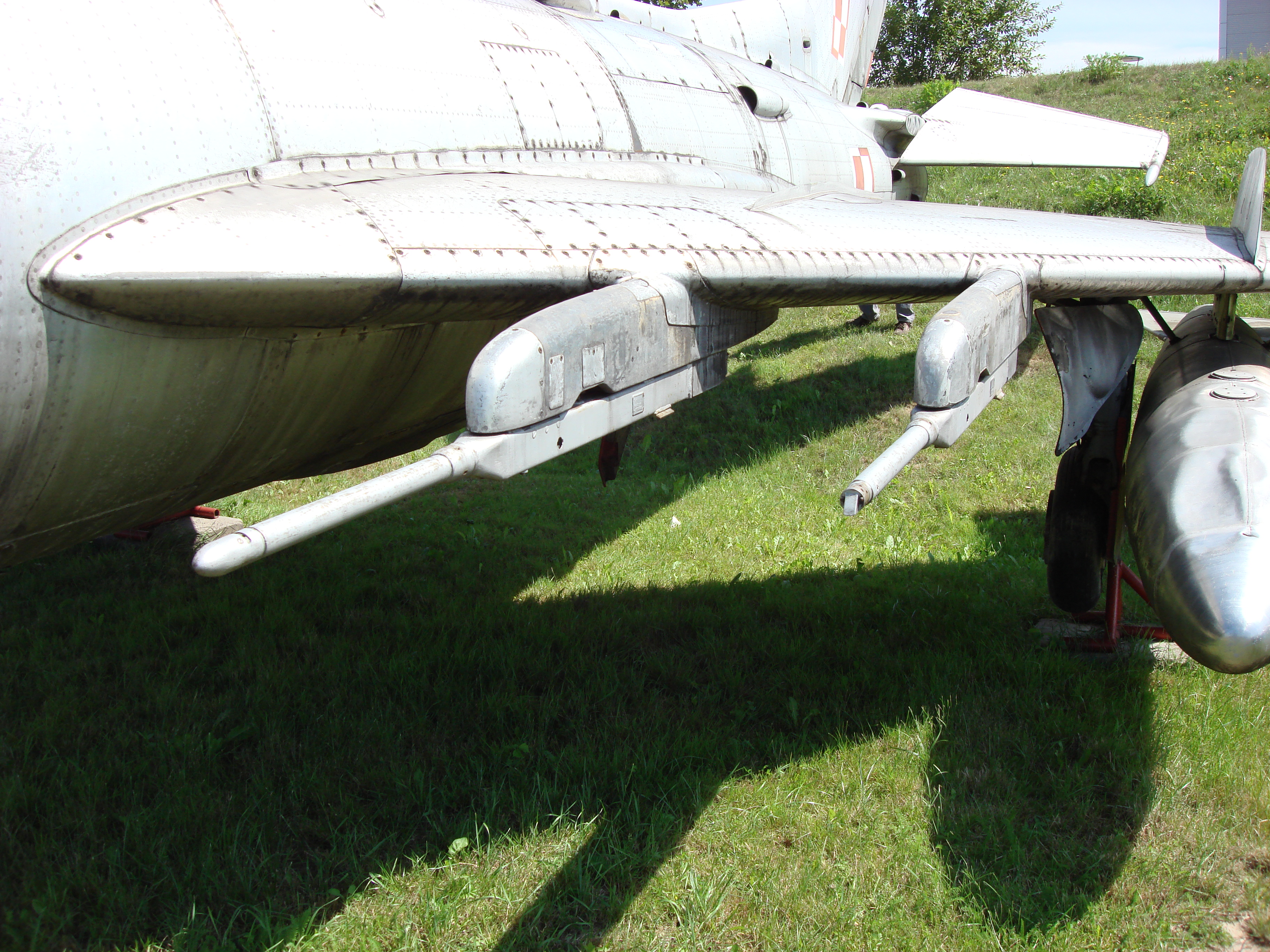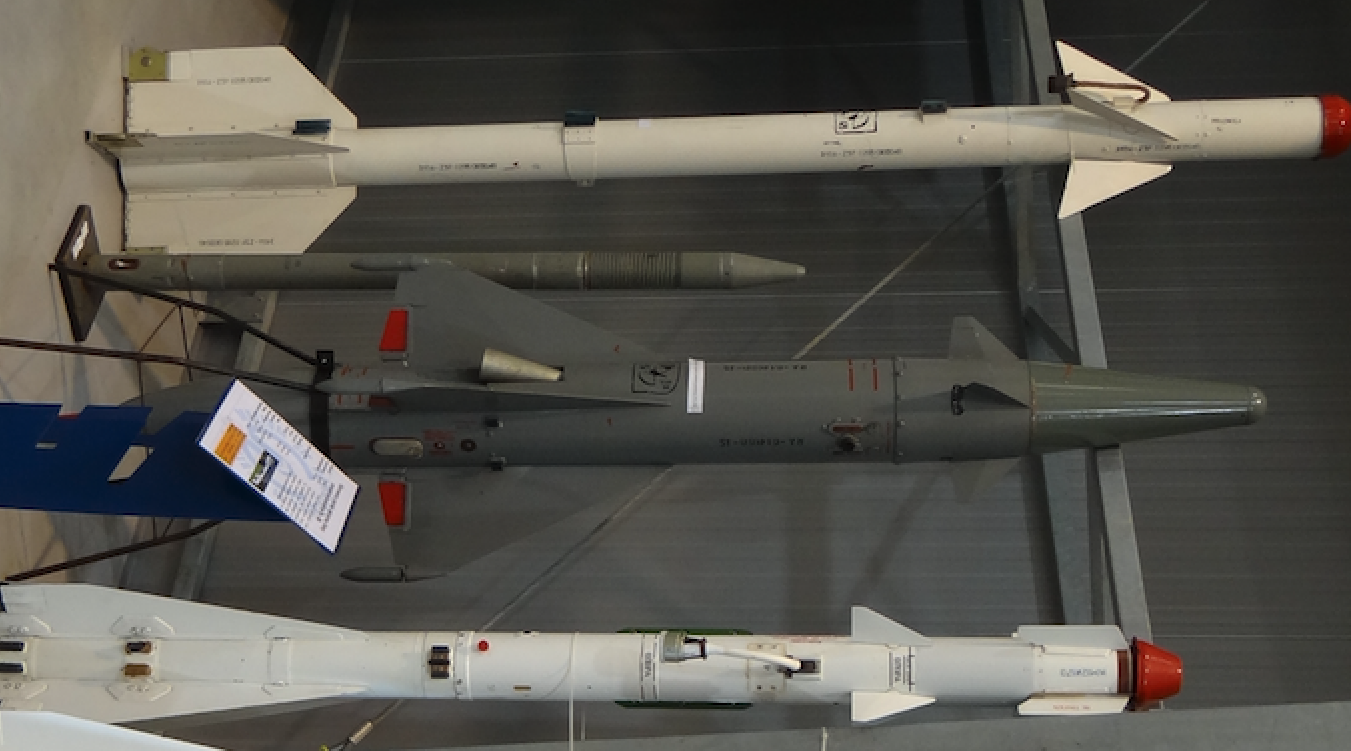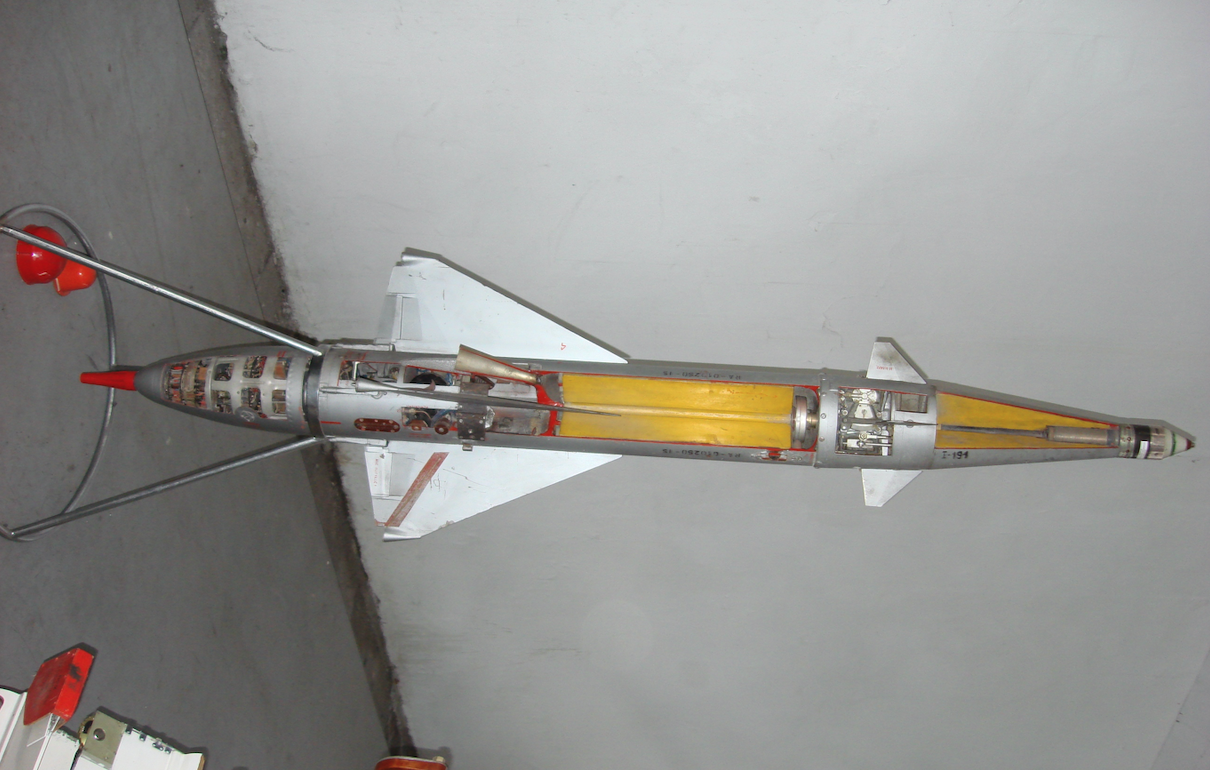Kraków 2020-10-10
RS-2 (K-5) RS-2 guided missile.
On April 16, 1949, Lockheed built and performed the first flight of the YF-94, which entered service with the USAF as the Lockheed F-94 A Starfire. A few months later, a version of the Lockheed F-94 C Starfire was introduced into service, with only air-to-air missiles as armament. The plane had 48 70 mm missiles. 24 missiles were placed in the front of the fuselage, and the rest in trays at the ends of the wings. The rocketization of the battlefield proceeded rapidly.
From 1947, work on a missile using a semi-active radar guidance system was started in the USA. In English it is called Beam Riding. The flight of the missile in the beam is based on the signal directed towards the target from the attacker’s aircraft’s radar. The signal goes to the receiver in the missile, which, based on the analysis of this signal, directs to the target. The signal does not have to be strong as it is not necessary to use it for target tracking as well. The main application of this type of system is the destruction of aircraft or tanks. How does such a system work? First, the targeting station directs a narrow radar beam at the enemy aircraft. The missile is then launched and at some point after firing the missile is "picked up" by the radar beam. From this point on, the missile tries to stay inside the beam, while the targeting station keeps the beam on the target. The missile controlled by the computer inside it goes to the target. The first Hughes Aircraft AIM-4 Falcon missile was created using this principle.
RS-1U (K-5) missile.
In 1948, at the CCCP in the KB-1 office, a design department was established, headed by the engineer Dmitry Ludwigowicz Tomaszewicz. The goal of the team was to work on guided missiles using the Beam Riding principle. In 1951, a cell was created under the direction of engineer K. Patruchin, whose task was to build a small air-to-air missile. Some components of the new missile were developed in other design offices. For example: a solid fuel engine, warhead, and proximity fuse. The main task of the engineering team was to develop the missile control system. In 1952, as a result of the CCCP intelligence activities, the task carried out received better financing. The engineering team was enlarged. The subject of the task was also clarified – Fighting enemy bombers in all weather conditions, from the rear hemisphere. Originally, the MiG-15 P, MiG-17 P, and Jak-25 planes were selected for the role of the carrier of the new missile. All of these planes had Izumrud radars. Ultimately, the MiG-17 PF and MiG-19 aircraft were selected.
The first test pieces of the missile were completed in December 1952. In the spring of 1953, the first ground tests began. In the summer of 1953, tests were carried out to drop the MiG-15 missile from a non-propelled missile with the task of testing the guidance system.
In October 1953, the entire task was transferred to the new OKB-2 office, headed by engineer Paweł Gruszyn. It was then that the missile system received the plant designation K-5. There were many changes in the missile. The hull was extended by 0.30 m to accommodate the improved equipment. The control system has been modified. The test carrier of the missile was the MiG-17 (SP-6) aircraft. Projectiles were fired at the cell planes. It turned out that the operating time of the missile’s rocket engine is too short and the range is insufficient.
In March 1955, a full test of the K-5 missile was conducted. The target was a remote-controlled Tupolev Tu-4 bomber. During subsequent tests, 71 K-5 missiles were fired. The K-5 system was adopted by the CCCP in 1956. It was the first air-to-air guided missile deployed in the history of the CCCP. Launching production and operating the system faced many difficulties. The factory that produced the K-5 missiles had no experience with missile weapons. In total, more than 3,000 RS-1U missiles were built, but hundreds of missiles were not completed.
The system is designated S-1-U. 4 K-5 missiles on APU-4 beams were mounted on MiG-17 PFU aircraft. MiG-17 PFU planes were deprived of small arms. The plane has the RP-1U radar, cooperating with the K-5 missile.
Description of the RS-1U missile (K-5).
The fuselage of the RS-1U missile has the shape of a spindle. The aerodynamic system is duck-type, meaning the wings are back, and the tail is in the front. The tail and wings are in a cross pattern. The wings have an approach angle of 60 degrees and a trailing edge of -12 degrees. The tail also has a triangular outline, the rake angle is 45 degrees and the trailing edge is -5 degrees. There are smoke generators at the ends of the wings, which are to facilitate the observation of the fired missile by the pilot. The projectile’s hull and aerodynamic surfaces are made of aluminum and magnesium alloys.
The rocket engine is a powder-based solid fuel engine with a thrust of 13.15 kN. The motor body is made of steel. Two engine exhaust nozzles are located on the side of the fuselage and are angled at 15 degrees from the axis. The fuselage of the projectile is protected against the influence of hot gases with asbestos covers.
The fuselage of the RS-1U missile is divided into five sections, the first three of which contain a warhead with a forced fragmentation of the cargo shell and a weight of 9.25 kg, the RW-1U (AR-43) proximity fuse with a ring sensor located in the front part of the missile, servomechanisms, stabilization systems and rudder drives. There’s a rocket engine here too. In the rear part of the rocket, there are guidance systems with power and actuating systems and a compressed air cylinder. The controls are operated with compressed air. The final part of the missile’s fuselage ends with the RP-1U radar receiver. It houses systems that receive radio pulses that guide them to signals that control and correct the flight of the missile. Electricity is generated by an air turbine that moves a generator. The proximity fuse operates at a distance of 10 m from the target. The self-destruction system will become active 13-23 seconds after the missile is fired.
The RS-1U rocket uses beam-rider guidance, which means that the target is continuously illuminated by the carrier’s on-board radar until it hits the target. Permanent highlighting of the target excludes the possibility of a defensive maneuver by the attacking pilot. The S-1-U system detects a bomber-sized target from a distance of 6-10 km. The pilot uses the ASP-2NN or ASP-5N sight.
Attack procedure.
The pilot of the RS-1U (K-5) missile carrier is directed to the target area by the ground command post. With the help of the Izmrud on-board radar, the pilot finds the target. From a distance of about 4 km, the S-1-U system can automatically stay in the radar beam. The missile is fired from a distance of 2-3 km. At the same time, the fighter must be at an altitude of 5,000 – 10,000 m. These limitations result from the performance of the missile, whose engine loses thrust at higher altitudes, and the guidance system. The guidance system is ineffective at low altitudes due to interference from the reflection of the radar beam from the ground.
RS-2U (K-5M) missile.
The RS-1U (military designation) K-5 (factory designation) missile had significant limitations, so the further development of the missile was continued. The RS-2U missile was created, which began to be mounted on MiG-19 PM aircraft. Work on the RS-2U (K-5M) began in 1954. The first launch of the new missile took place in 1956. But the missile still had disadvantages and limitations.
The new missile system was designated S-2-U. The first RS-2U serial missiles were built in 1957. A total of 13,700 missiles were built.
The modification of the system consisted in improving the parameters of the missile: the range of its firing, increasing the range, improving the reliability of electronics, etc. Despite a number of modifications introduced, the RS-2U missile still had a design similar to the original. It has retained a spindle-shaped fuselage as well as aerodynamic surfaces arranged in a duck-shaped pattern. The hull of the missile was extended by 0.14 m. The proximity fuse operates from a distance of 15 m from the target. The missile has a new PRD-45 rocket engine. Compressed air supply increased. The fuse in the RS-2U has a different shape than that of the RS-1U missile, which makes it easy to distinguish between missiles. The new warhead weighs 13 kg. The missile can be fired from the ceiling from 1 500 m up. You can also launch a missile at a target 2,000 meters lower than the attacking aircraft.
The RS-2U missile is already compatible with another radar, the RP-2U (Izumrud-2) radar sight specially developed for this purpose. Equipped with RS-2U missiles, the MiG-19 PM fighters carry up to 4 rockets mounted on APU-4 beams. The rockets themselves could be fired singly, in pairs, or in a volley, at fixed intervals.
RS-2US (K-5MS) missile.
The RS-2US missile became an armament for the Suchoj Su-9 aircraft and MiG-19 PM, MiG-21 PF, MiG-21 PFM and subsequent fighters. However, because these planes had different performances, a switch was introduced, which had to be set in the appropriate position depending on the carrier before take-off. Changing the position of the switch changed the gain signal of the radio control unit. Depending on the selected option, the operating characteristics of the rocket rudders changed. It was necessary due to the fact that in the case of the Suchoj Su-9 the rockets were to be used at higher altitudes. The introduced modifications made it possible to use the missile at altitudes of up to 20 500 m.
In May 1958, factory trials began with the use of five T-43 (Su-9) prototypes adapted to carry new missiles. Subsequently, state trials began, which were completed in the early 1960s. This is how the Su-9-51 (T-3-51) system was created, which was used only in CCCP.
In 1961, one of the serial MiG-21 PF aircraft was equipped with a CD-30TP (RP-21M) radar and adapted to carry RS-2US missiles. After several years of trials and further development works, in 1965 another variant of the MiG-21 PFM, capable of carrying RS-2US missiles, finally entered mass production.
Serial production of the RS-2US missiles amounted to approximately 31,000 copies. The missiles went to all socialist and partner countries of the CCCP. Despite the low effectiveness of the missiles, they were withdrawn from service only in the mid-1990s. A maneuverable target could easily outmaneuver the RS-2US missile.
Missiles in Poland.
The RS-2U missiles were delivered to Poland together with the MiG-19 PM aircraft.
From 3-12-1957, MiG-19 P planes were delivered to Poland, with only cannons as weapons. It was only in 1959, in the third delivery, that 14 MiG-19 PM planes, equipped with RS-2U missiles, arrived in Poland. The planes do not have barrel armament. Subsequently, RS-2US missiles were delivered to Poland, which were also used on MiG-21 aircraft. Although the MiG-21 aircraft mainly used infrared guided missiles.
Description for the photo: MiG-19 PM nb 905. The aircraft used in the 28th PLM in Słupsk. After the service, the plane went to the Polish Aviation Museum in Czyżyny, in Krakow.
In Poland, the RS-2US missiles were withdrawn from service in 2003, when all MiG-21 versions were withdrawn from service. Using the stocks of these missiles at the Air Force Institute of Technology in Warsaw, the Rocket Air Target (RCP) was constructed on their basis and put into use in several subsequent modifications, marked SRCP and SRCP-WR. The RCP family’s air targets are intended for fire training of missile forces. They imitate a real air target with an effective radar reflection area of about 5 m2, which is typical for a classic fighter plane. The target missile is fired from the Suchoj Su-22 carrier plane from a level flight with an altitude of 2,000 m to 10,000 m.
RS-2US (K-5MS) missile data:
The missile was put into service in 1960. Projectile length 2.50 m. Fuselage diameter 0.20 m. Wingspan 0.65 m. Projectile weight 82.7 kg. Range 1,950 m – 6,000 m. Minimum firing ceiling 1,000 m. Maximum firing ceiling 16,500 m. Maximum speed 800 m / s. The minimum speed of the carrier at launch is 650 km / h. Radio fuse and self-destruction system. A 13 kg high-explosive warhead has a bursting charge that creates a cloud of sharp debris.
Written by Karol Placha Hetman


